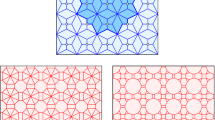Abstract
In the Escherization problem, given a closed figure in the plane, the objective is to find a closed figure that is as close as possible to the input figure that tiles the plane. Koizumi and Sugihara’s formulation reduces this problem to an eigenvalue problem. In their formulation, only one of the potentially numerous templates is used to parameterize the possible tile shapes for each isohedral type. In this research, we try to search for the best tile shape using all possible templates for the nine most general isohedral types. This extension provides a considerable flexibility in possible tile shapes and improves the quality of the obtained tile shapes. However, the exhaustive search of all possible templates is computationally unrealistic using conventional calculation methods, and we develop an efficient algorithm to perform this in a reasonable computation time.











Similar content being viewed by others
Notes
It is possible to compute the basis of \(\text{ Ker }(A)\) in \(O(n^2)\) time by utilizing the sparsity of the matrix B, but it takes \(O(n^3)\) time to orthonormalize the obtained basis vectors because they are no longer sparse.
The property of scale-invariance is not necessary here. Therefore, a distance measure defined as \(\min _{\theta } {\left\| R(\theta ) U - W \right\| }^2\) gives the same result, except for the size.
We created this goal polygon by measuring the coordinates of the points from the figure in their paper, and the obtained tile shape is slightly different from theirs.
References
Arkin, E.M., Chew, L.P., Huttenlocher, D.P., Kedem, K., Joseph, S.B.: An efficiently computable metric for comparing polygonal shapes. IEEE Trans. Pattern Anal. Mach. Intell. 13(3), 209–216 (1991)
Grünbaum, B., Shephard, G.C.: Tilings and Patterns. WH Freeman and Company, New York (1987)
Heesch, H., Kienzle, O.: Flächenschluß: System der formen lückenlos aneinanderschließender Flachteile. Springer-Verlag, Berlin (1963)
Imahori, S., Kawade, S., Yamakata, Y.: Escher-like tilings with weights. In: Proceedings of Discrete and Computational Geometry and Graphs, JCDCGG 2015. Lecture Notes in Computer Science, vol. 9943, pp. 132–142. Springer, Cham (2015)
Imahori, S., Sakai, S.: A local-search based algorithm for the escherization problem. In: The IEEE International Conference on Industrial Engineering and Engineering Management, pp. 151–155 (2012)
Kaplan, C.S.: Introductory tiling theory for computer graphics. Synth. Lect. Comput. Graph. Anim. 4(1), 1–113 (2009)
Kaplan, C.S., Salesin, D.H.: Escherization. In: Proceedings of the 27th Annual Conference on Computer Graphics and Interactive Techniques, pp. 499–510. ACM Press/Addison-Wesley Publishing Co. (2000)
Koizumi, H., Sugihara, K.: Maximum eigenvalue problem for escherization. Graphs Combin. 27(3), 431–439 (2011)
Liu, X., Li, X., et al.: The artwork generating system of escher-like positive and negative pattern evolution. In: ACM SIGGRAPH 2017 Posters. ACM (2017)
Ono, S., Kisanuki, M., Machii, H., Mizuno, K.: Creation support for escher-like tiling patterns by interactive genetic algorithms. In: SIGGRAPH Asia 2014 Posters, ACM (2014)
Ono, S., Kisanuki, M., Machii, H., Mizuno, K.: Figure pattern creation support for escher-like tiling by interactive genetic algorithms. In: Proceedings of the 18th Asia Pacific Symposium on Intelligent and Evolutionary Systems, vol. 1, pp. 421–432. Springer, Berlin (2015)
Saad, Y.: Numerical Methods for Large Eigenvalue Problems, revised edn. SIAM, New York (2011)
Schattschneider, D., Escher, M.C.: Visions of Symmetry. Harry N. Abrams, New York (2004)
Werman, M., Weinshall, D.: Similarity and affine invariant distances between 2D point sets. IEEE Trans. Pattern Anal. Mach. Intell. 17(8), 810–814 (1995)
Acknowledgements
We would like to thank S. Sakai and S. Kawade for the goal figures used in the experiments. This work was supported by JSPS KAKENHI Grant No. 17K00342.
Author information
Authors and Affiliations
Corresponding author
Additional information
Publisher's Note
Springer Nature remains neutral with regard to jurisdictional claims in published maps and institutional affiliations.
Electronic supplementary material
Below is the link to the electronic supplementary material.
Appendix: Parameterization of Tile Shapes for IH7
Appendix: Parameterization of Tile Shapes for IH7
For any \(i \in I\) and \(k \in K_i\), the matrix \(B_{ik}\) can be constructed in O(n) time, as described in Sect. 3.3. However, this may be nontrivial if a template has two adjacent J edges that must form a specified angle. We present another example of how the matrix \(B_{ik}\) is constructed in O(n) time for the template of IH7, which includes such J edges.
Figure 12 shows the template of IH7 represented in the same way as in Fig. 3. The constraint conditions imposed on the tiling vertices are expressed by
where \(\theta = 120^{\circ }\). Then, we can obtain the matrix \(B_v\) in the same way as in Eq. (16).
The xy-coordinates of the n points are constrained by the following equations (only the constraints for the first and second tiling edges are shown):
By parameterizing \(x_{h(2)-i}-x_{h(2)}\) and \(y_{h(2)-i}-y_{h(2)}\) as \(\xi _{2i}^s\) and \(\xi _{2i+1}^s\), respectively, the tile shape U is then parameterized as follows (only the xy-coordinates of the first and second tiling edges are shown):

where the blank elements in the column vectors are zero. The matrix \(B'_d\) (see Eq. 22) is then given by the following formula:

where the row vectors of \(B'_d\) are given by
Obviously, we can construct the matrix \(B_{ik}\) in O(n) time because the matrix \(B_s\) is sparse, all column vectors of \(B_s\) are mutually orthogonal, and the matrix \(B'_d\) is obtained in O(n) time.
In fact, we must consider \(\theta =-120^{\circ }\) as well in the template of IH7. This can be easily implemented by considering the reverse numbering scheme of the goal polygon. The same process is necessary for IH21 and IH28.
Rights and permissions
About this article
Cite this article
Nagata, Y., Imahori, S. An Efficient Exhaustive Search Algorithm for the Escherization Problem. Algorithmica 82, 2502–2534 (2020). https://doi.org/10.1007/s00453-020-00695-6
Received:
Accepted:
Published:
Issue Date:
DOI: https://doi.org/10.1007/s00453-020-00695-6





